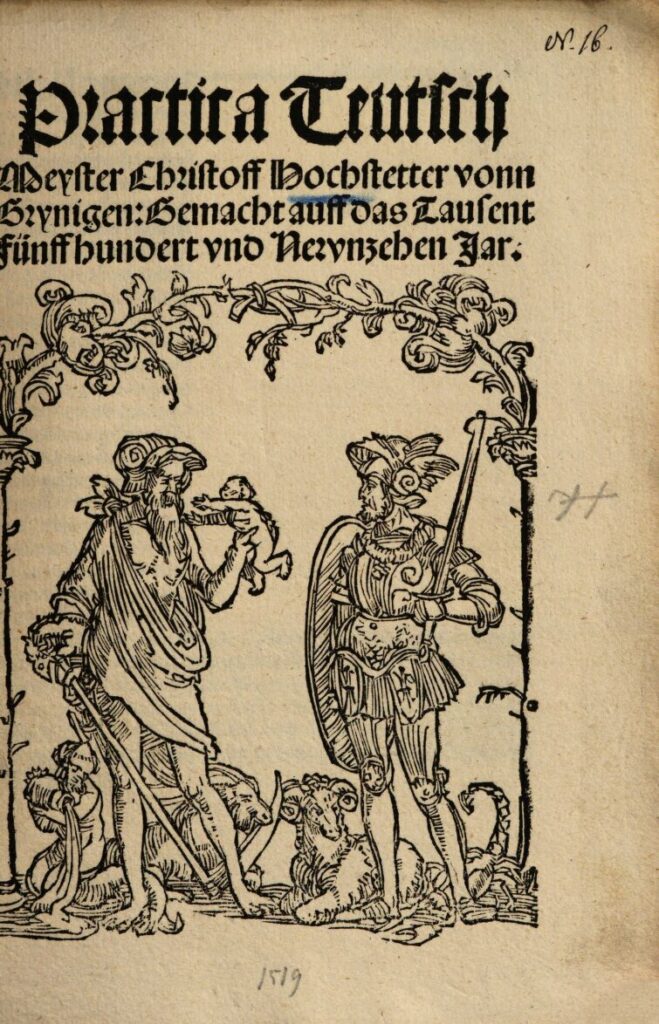Glossary
Prognostication

Other languages
- Dutch: prognosticatie (spotprognosticatie), practica, astrologische voorspelling
- French: prognostication
- German: Prognostik, Practica
- Italian: pronostico
- Polish: prognostyk, przepowiednia
- Spanish: pronóstico
Material form
Printed bookSubject
Knowledge and skills, News and current affairsDescription
Booklet in almanac form or part of an almanac containing (almost) exclusively predictions for the coming year, describing seasons, months, expected harvests, foreseeable diseases, wars, etc. After its heyday in the 15th-17th centuries, the genre slowly descended into popular entertainment in the 18th and 19th centuries. Prognostications were also published and sold separately, often in octavo or quarto format. In this form they played a political role in different turbulent periods for instance in the Northern Netherlands, England and France. From the 16th century onwards this genre was satirised via mock prognostications.
Related terms
prophecy, mock prognostication, almanac, lunary
Sources
A. Fox, The Press and the People: Cheap Print and Society in Scotland, 1500-1785 (Oxford: Oxford University Press, 2020), chapter 9: ‘Almanacs and Prognostications’.
S. González-Sarasa Hernáez, Tipología editorial del impreso antiguo español, thesis Universidad Complutense de Madrid (2013), 654-655 (‘Pronóstico’). https://eprints.ucm.es/id/eprint/24020/
J. Green, Printing and Prophecy. Prognostication and Media Change, 1450-1550 (Ann Arbor: The University of Michigan Press, 2012).
S.M. Johnston, ‘Printing the Weather: Knowledge, Nature, and Popular Culture in Two Sixteenth-Century German Weather Books’, Renaissance Quarterly 73:2 (2020), 391-440.
P. Jensen, Astrology, Almanacs, and the Early Modern English Calendar (Andover: Routledge, 2020), 57-73.
H. van Kampen et al., Het zal koud zijn in ‘t water als ‘t vriest. Zestiende-eeuwse parodieën op gedrukte jaarvoorspellingen (‘s-Gravenhage: Martinus Nijhoff, 1980). https://www.dbnl.org/tekst/_kou002koud01_01/index.php
L. Kassell, ‘Almanacs and Prognostications’, in: J. Raymond (ed.), The Oxford History of Popular Print Culture, Vol. 1 (Oxford: Oxford University Press, 2011), 431-442.
D. Kempkens, ‘Der Erfolg der Prognostica auf dem Buchmarkt in der frühen Neuzeit’, Jahrbuch für Kommunikationsgeschichte 16 (2014), 5–27.
H.J. Nalis and J. Salman, ‘”Wie sal ick dan wes goedes konnen prognosticeren?”. Deventer almanakken en prognosticaties in roerige tijden (1555-1610)’, in: Deventer jaarboek (1994), 6-39.
O. Niccoli, Prophecy and People in Renaissance Italy (Princeton, N.J.: Princeton University Press, 1990).
J. Seethaler, ‘Kalender und Prophezeihungen’, in: H. Petschar (ed.), Alpha & Omega. Geschichten vom Ende und Anfang der Welt (Wien/New York 2000), 243–255.
F.P. Wilson, ‘Some English Mock-Prognostications’, in: idem and H. Gardner (eds.), Shakespearian and other studies (Oxford: Clarendon Press, 1969), 251-284.

